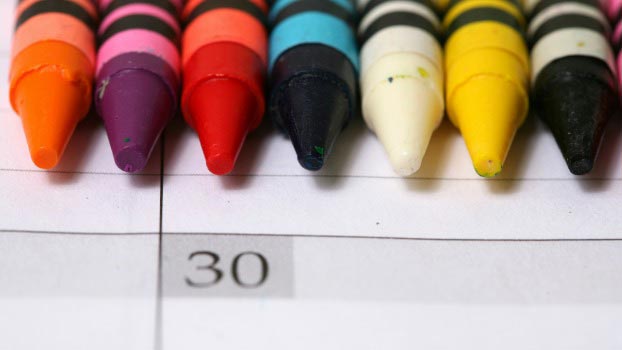
In preschool, it is important to familiarize toddlers with common ideas and practices of every day life. Calendar time is an educational tool used in many preschool environments to introduce the concepts of time and its progression. Even though there is much debate about whether or not the study of this topic is beneficial for children younger than seven, there are many additional educational opportunities that can be learned through the practice of calendar time in the classroom. Teaching with and about calendars helps toddlers learn and become familiar with temporal concepts, new vocabulary, number sequencing and patterns. All of these are all primary skills that can be discovered by incorporating calendar time in the early learning classroom.
Calendar Time in Preschool
For the most part, children can understand broad temporal concepts, such as later, before, and after. With the use of picture schedules, these ideas are discovered and reviewed on a daily basis by preschoolers. For example, take a day in the life of a preschooler: arrive at school, sit in circle time, musical play, snack time, naptime, outside play, go home. Creating an image for each of these activities, organizing them in order of time, and making the daily schedule visible to students facilitates the understanding of temporal concepts. Toddlers will begin to be able to recognize perceptions of time on a rudimentary level: after circle time comes musical play; before going home, there is outside play.
New vocabulary is also introduced to toddlers through the use of calendar time in the preschool classroom. Discovering new words, such as day, week, month, and year can be exciting for toddlers. Although they may not pick up on the true meaning of these words, they will have fun adding them to their vocabulary and using them in classroom and home discussions. Additionally, other new words that can be introduced to preschoolers include those concerning the seasons and types weather. Displaying the different seasons and weather with the corresponding months of the year facilitates new and interesting classroom conversations.
Incorporating the ideas of yesterday, today, and tomorrow will help preschoolers to understand sequence. A great way to include these new words is by having an attendance photo chart. Encouraging children to get involved in taking daily attendance creates another way to learn about the concept of time by determining who is in class today. Comprehension of the terms later, before, and after help to transition into the beginning of the understanding that yesterday was before and tomorrow is after. Having a bulletin board that represents this new terminology visually assists in early learning experiences regarding the relative concepts of time. In addition, patterns are recognized through teaching calendar time in the classroom. The days of the week and the months of the year are recurrent within time. By providing a visual layout of this, toddlers will be able to identify these patterns.
The idea of an interactive calendar for preschoolers is probably one of the best ways to incorporate calendar time into a daily lesson, while not putting too much emphasis on the children retaining the information. Having a calendar set up for toddlers to engage and play with on their own or with peers can be extremely beneficial in helping them to recognize and become familiar with the use of a calendar for day to day living.